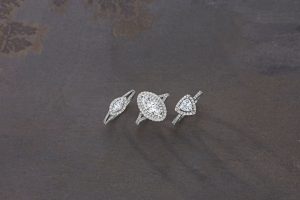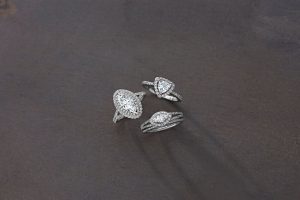
Suzanne Miglucci has been the president and CEO of moissanite manufacturer and marketer Charles & Colvard since December 2015. Here, she gives JCK an update about what’s happening with her Research Triangle Park, N.C.—based company and talks about the company’s relationship with Helzberg, whether consumers know moissanite, and just how it views lab-grown diamonds:
JCK: You just gave a presentation about omnichannel. As a company that is generally considered a distributor, how does omnichannel fit into your marketing?
Suzanne Miglucci: It has to be a careful balance. We were traditionally a distribution channel. We created these beautiful gemstones and we relied on the distribution network to market our goods for us. Where we failed is we did not engage the consumer. We relied on our retailers to educate consumers about what moissanite was.
We were there in the midst of every other gemstone so we got lost in the shuffle. We didn’t own our brand. It’s about creating that relationship with the consumer and bringing awareness to the brand. Then it’s a rising tide that lifts all boats.
JCK: Do you consider your brand moissanite or Charles & Colvard?
Miglucci: Moissanite is a mineral. We don’t brand minerals. We do brand ForeverOne, which is our colorless moissanite gemstones. The full brand is Charles & Colvard.
JCK: Do you think there’s still limited awareness of moissanite?
Miglucci: Do I ever. It’s been around 22 years and I still meet people every day who don’t know it. Educating the audience is so important. That’s why we thought it was so important that the American Gem Society recognized moissanite as a gemstone. We have been a member for years but they have never come forward to say this is an authentic gemstone.
JCK: Do you have statistics on consumer awareness of moissanite?
Miglucci: We don’t have those but I could give you growing e-commerce numbers. That to us is an indicator that people are increasing their awareness. It went off patent a few years ago and there are now other companies beating the drum and there is more awareness of the gemstones. There are a lot more of us out there. It also helps to have lab-created diamond companies talking about the value of lab-created diamonds. Five years ago we were up against mined diamonds and trying to validate lab-created products. Now I don’t have to educate the market on the value of lab-created.

JCK: How do lab-created diamonds affect your business?
Miglucci: I say that we fall in an interesting white space between lab-created diamond and cubic zirconia. We have lab-created, we have mined diamond, and then except for white sapphire, there are no other gemstones. We fill that space in the middle. I think we are nicely placed.
If you look at the Morgan Stanley report on the lab-grown diamond industry, it says the diamond business is an $80 billion industry, and as much as 10 percent of it might go lab-created.
JCK: How is your relationship with Helzberg Diamonds going?
Miglucci: We are excited about it. It goes back to omnichannel. We didn’t have a substantial physical presence in the market until Helzberg. It’s very important to be everywhere that the consumer is.
We started with shipping to augment their online offerings. They invited us to a 26-store test. We were in 50 stores by the end of the year. Helzberg is finding it brings in a new customer. Diamond consumers don’t transition to moissanite and the moissanite consumer doesn’t transition to diamond.
JCK: Do you think that you will ever launch brick-and-mortar stores?
Miglucci: As a good CEO and board member I always have to look for my shareholders’ best interests. We increased our relationship with Helzberg and if other retail opportunities come, we are very open to it. We make a nice margin on our e-commerce business. We will be judicious on any decision on brick-and-mortar expansion.
JCK: You have said you want to target millennials in your marketing.
Miglucci: They will be the future of our growth. When they leave college and have to get jobs and dress for success we can help them with their fashion jewelry. If they believe in moissanite at that point we can convert them into bridal. What we like about millennials is they didn’t grow up with the diamond story, the De Beers ads that you and I grew up with. They are very ecoconscious. They want to know the story of the mines, they want to know the source of the metals that we use—that it’s all responsibly sourced.
JCK: When you call your products ecofriendly, do you think that has a negative connotation for other industry products?
Miglucci: I appreciate the rest of the trade and they laid the groundwork for everything we are doing. We are trying to meet the specific needs of our customers. Ecofriendliness is important to our consumers. That doesn’t mean that I am going to beat up the rest of the industry, it just means that we bring a different value proposition.
JCK: What are the pros and cons of having your patent lapse?
Miglucci: Let me answer pro and pro. On the pro side, it has given more exposure for consumers. On the other pro, we have a 22-year head start on those competitors. We are seeing a lot of body color on their goods but we are also seeing a lot of clarity issues with their goods. It has taken us 22 years to get to where we are. I’m not too worried.

JCK: Can you tell me about your new program for bigger sizes and different shapes?
Miglucci: It’s all based on demand. We expanded some of our existing shapes into more sizes. When we went to JCK Las Vegas in June of this year we brought forward some pieces with couture-style jewelry with massive gemstones. It’s something we can do because we are working from the raw material. You can say: Let’s bring a 7 ct. or 8 ct. diamond. So we created these exotic gems and brought them to JCK. We were pleasantly surprised with the success of these exotic gems. We are creating them on a special order basis.
(Images courtesy of Charles & Colvard)
- Subscribe to the JCK News Daily
- Subscribe to the JCK Special Report
- Follow JCK on Instagram: @jckmagazine
- Follow JCK on X: @jckmagazine
- Follow JCK on Facebook: @jckmagazine